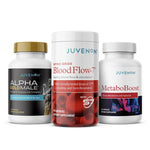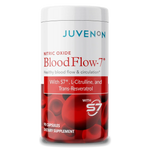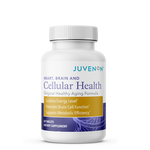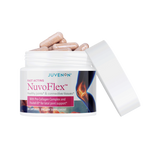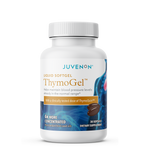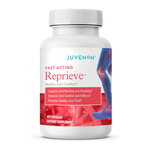 Knee pain, no matter the cause, can really put the brakes on the active, healthy, and adventurous lifestyle you want as you age.
Knee pain, no matter the cause, can really put the brakes on the active, healthy, and adventurous lifestyle you want as you age.
Unfortunately, joint discomfort can be caused by a number of factors: excess weight, injuries, free radical damage, and even aging itself.
As we age, the “wear and tear” on the joints in the knee adds up — causing the natural cushioning there to wear down and lead to bone-on-bone friction, which causes discomfort. If you’re overweight, this can accelerate the joint wear and tear.
However, knee discomfort or other joint aches don’t have to limit your ability to enjoy life to the fullest.
In this post, we’ll review:
- Several strategies that may help you to reduce your knee discomfort
- Knee-friendly exercises that may help you lose weight and improve your overall wellness,
- If walking can help to relieve knee pain or help you lose weight,
- And how supplements like Nuvoflex and Reprieve by Juvenon can help support your goals.
6 Tips to Relieve Knee Pain
Here are six potential solutions that may help you address your joint discomfort and feel more comfortable, allowing you to lead a more active lifestyle.
Not all of these may apply to your unique knee and joint health situation, so keep that in mind when reading through these. Additionally, be sure to consult your trusted healthcare provider if your joint discomfort is increasing in intensity or affecting your ability to lead a normal life.
1. Weight loss
If you are overweight, this extra weight can put extra stress on your knees — even if you don’t necessarily feel any knee or joint discomfort.
This extra strain can put you at an increased risk of knee injury, but it also accelerates the natural wear and tear that occurs on the joints in your knee.
Carrying excess weight also changes your gait, or the body mechanics at play when you walk, which may naturally lead to an increase in discomfort since your knees, legs, and hips aren’t moving properly. [1]
It is so much easier said than done to just “lose weight” and for anyone who is trying and struggling, be compassionate with yourself and know that it’s not easy for some people.Losing weight is harder than the medical world lets on. Fortunately, though, even a small amount of weight loss can help correct knee discomfort, reduce strain on your knees and joints, and even correct your gait. [1]
Some of the strategies listed below may help you lose weight, but generally the best approach for weight loss is to focus on what you eat. Avoiding processed foods and sticking to natural, whole foods is an easy way to reduce calories, as well as help to regulate your appetite and the hormones that may play a role in weight control.
2. Nutrient and antioxidant dense diet
In addition to affecting your weight, a healthy diet may affect your knee health in other ways. Compounds called free radicals — which can enter our body from food, water, air, medications, cleaning products, and personal care products — can build up in high levels that can start to damage your cells. This process is called oxidative stress. [2]
But how can this affect your knees? This oxidative stress can happen anywhere in your body and may compromise the health of your joints as it damages your cells.
However, antioxidants — which are phytochemicals (plant chemicals) found in fruits and vegetables — can help to counteract this damage. Therefore, they’re called antioxidants — because they can help alleviate oxidative stress.
For this reason, you should aim to include a variety of fruits and vegetables in your diet along with a range of all plant foods from whole grains, to legumes, nuts and seed too. Antioxidants also provide color to plant foods, so try to eat an assortment of colors to get the widest possible variety of antioxidants.
Additionally, these foods are rich in vitamins and minerals, and most vegetables are very low in calories but high in volume — making them a great way to fill up your plate if you’re trying to lose weight.
3. Low impact weight bearing exercise
And what about exercise? The very idea may seem daunting if you’re dealing with knee discomfort.
However, low impact exercise can help relieve your knee pain in a number of ways.
First, it may help increase your mobility and range of motion. Have you ever noticed that your knee seems stiffer than ever after you’ve been sitting still for a while?
Purposefully moving your body can help keep those knee joints flexible and comfortable.
Additionally, weight bearing exercise may help to strengthen your bones as well — which is key for avoiding injury or osteoporosis as you age. Low impact exercises like cycling and swimming can be excellent for these purposes. [3]
What about walking?

Walking is also an ideal way to stay active, especially if you don’t have the means to engage in other types of weight bearing exercise. Walking requires zero equipment, zero memberships, and honestly zero fitness. No matter how sedentary you’ve been, you can still take a few steps or even just a short walk to check the mail.
This makes walking a perfect starting point.
However, research shows that while walking may help to maintain bone health, it won’t strengthen your bones further. [3]
Additionally, walking alone may not burn enough calories to help you lose weight (if you need to lose weight), unless you also make some changes to your diet. That said, even a 10-minute post meal walk can lower post prandial (post meal) blood sugar levels and bring you back into a healthy range. The science is clear that healthy glucose is favorable for weight loss.
4. Strength training
In addition to low impact cardio exercises like cycling, walking, or swimming, strength training (which encompasses resistance training or weightlifting) is also an important type of exercise that should be included in your weekly routine.
Like cardio, strength training can help to improve your bone density. However, where it really shines is in increasing your muscle mass. Weak muscles, or having low muscle tone, can actually contribute to joint discomfort because your muscles aren’t providing any support for your joints.[4]
However, increasing your muscle mass helps your muscles to be more supportive of your joints, cradling them in place and helping to relieve discomfort.
5. Physical therapy
Another option if you’re dealing with persistent joint discomfort is to seek physical therapy. Many types of insurance no longer require a referral, so you may be able to schedule an appointment directly with a physical therapy office.
A physical therapist can help you improve your strength, flexibility, and range of motion — along with providing advice on exercises to help strengthen your muscles and stabilize your joints.
If you’re fearful about exercises because you don’t want to injure yourself or make your discomfort worse, physical therapy may be just what you need.
6. Supplements
A final way to help support your joints may be to include supplements. Two options from Juvenon — Reprieve and Nuvoflex — were formulated from the ground up using scientifically proven ingredients to help provide relief to achy joints.
Reprieve
The aptly named Reprieve is designed with several powerhouse ingredients to help provide a reprieve from even the strongest and most persistent joint aches.
These include:
- Boron: Boron is a requirement for strong, healthy joints, but it’s hard to get enough because the soil where our food grows has been so depleted. That’s why Reprieve is made with a high-quality boron source.[5,6]
- Corydalis yanhusuo root: With the active ingredient L-tetrahydropalmatine, which can help to block discomfort by activating dopamine receptors, it’s no surprise that C. yanhusuo has a long history of use in traditional Chinese medicine.[7]
- Milk thistle: Milk thistle extract contains the powerful silymarin compounds, which can help to neutralize free radicals and help ease the immune reaction that contributes to certain types of joint discomfort.[8,9]
- Angelica dahurica root: This traditional Chinese herbal medicine works to help neutralize free radicals and regulate blood flow to achy areas to provide relief.[10,11]
- Frankincense extract: One study has shown that taking frankincense extract daily for 120 days could significantly improve knee pain, stiffness, and functional capacity.[12]
Nuvoflex
Nuvoflex is specifically designed to support and bring relief to achy, sore joints. It helps to promote and maintain collagen, which is the flexible collagen matrix that provides support to bones, joints, muscles, and skin. Here are the ingredients you’ll find in Nuvoflex:
- Vitamin C: Vitamin C is an antioxidant nutrient that plays a number of roles in the body — not the least of which is to promote collagen synthesis. It can also help to protect against oxidative damage.[13,14]
- Boron: Like Reprieve, Nuvoflex also contains boron — this time, in a highly bioavailable (easy to absorb) calcium fructoborate form, which is the type found naturally in food.
- Amla fruit: Amla fruit extract, from the Indian amla fruit, prevents collagen from breaking down by inhibiting the enzyme collagenase type II. The end result is more joint-supportive collagen.[15]
- Icariside: Icariside, which is isolated from the Chinese herb epimedium, may help promote joint regeneration by directing stem cells to repair and restore damaged joint tissue.[16, 17]
These supplements, as a simple part of your daily routine, can help your body to naturally protect against oxidative stress while also providing what you need to optimize your joint strength and support the bones and muscles that stabilize your joints.
Takeaway
Knee pain does not have to stop you from living the life you want. Although wear and tear to your joints is a natural part of aging that may be accompanied by some discomfort, you may be able to alleviate the aches or slow down this progression by losing weight, eating an antioxidant-rich diet, engaging in low impact exercise and strength training, or visiting a physical therapist.
Additionally, Juvenon’s Nuvoflex or Reprieve supplements, with their powerful, proven ingredients, may also help you to recapture your vibrant and active life from joint aches.
References
- Li JS, Tsai TY, Clancy MM, Li G, Lewis CL, Felson DT. Weight loss changed gait kinematics in individuals with obesity and knee pain. Gait Posture. 2019;68:461-465. doi:10.1016/j.gaitpost.2018.12.031
- Alkadi H. A Review on Free Radicals and Antioxidants. Infect Disord Drug Targets. 2020;20(1):16-26. doi:10.2174/1871526518666180628124323
- Benedetti MG, Furlini G, Zati A, Letizia Mauro G. The Effectiveness of Physical Exercise on Bone Density in Osteoporotic Patients. Biomed Res Int. 2018;2018:4840531. Published 2018 Dec 23. doi:10.1155/2018/4840531
- Westcott WL. Resistance training is medicine: effects of strength training on health. Curr Sports Med Rep. 2012;11(4):209-216. doi:10.1249/JSR.0b013e31825dabb8
- Devirian TA, Volpe SL. The physiological effects of dietary boron. Crit Rev Food Sci Nutr. 2003;43(2):219-231. doi:10.1080/10408690390826491
- Newnham RE. Agricultural practices affect arthritis. Nutr Health. 1991;7(2):89-100. doi:10.1177/026010609100700204
- Zhou HH, Wu DL, Gao LY, Fang Y, Ge WH. L-Tetrahydropalmatine alleviates mechanical hyperalgesia in models of chronic inflammatory and neuropathic pain in mice. Neuroreport. 2016;27(7):476-480. doi:10.1097/WNR.0000000000000560
- Harrabi S, Ferchichi A, Bacheli A, Fellah H. Policosanol composition, antioxidant and anti-arthritic activities of milk thistle (Silybium marianum L.) oil at different seed maturity stages. Lipids Health Dis. 2018;17(1):82. Published 2018 Apr 16. doi:10.1186/s12944-018-0682-z
- Dupuis ML, Conti F, Maselli A, et al. The Natural Agonist of Estrogen Receptor β Silibinin Plays an Immunosuppressive Role Representing a Potential Therapeutic Tool in Rheumatoid Arthritis. Front Immunol. 2018;9:1903. Published 2018 Aug 17. doi:10.3389/fimmu.2018.01903
- Kang OH, Chae HS, Oh YC, et al. Anti-nociceptive and anti-inflammatory effects of Angelicae dahuricae radix through inhibition of the expression of inducible nitric oxide synthase and NO production. Am J Chin Med. 2008;36(5):913-928. doi:10.1142/S0192415X0800634X
- Moon YJ, Lee JY, Oh MS, et al. Inhibition of inflammation and oxidative stress by Angelica dahuricae radix extract decreases apoptotic cell death and improves functional recovery after spinal cord injury. J Neurosci Res. 2012;90(1):243-256. doi:10.1002/jnr.22734
- Umar S, Umar K, Sarwar AH, et al. Boswellia serrata extract attenuates inflammatory mediators and oxidative stress in collagen induced arthritis. Phytomedicine. 2014;21(6):847-856. doi:10.1016/j.phymed.2014.02.001
- Sharma G, Saxena RK, Mishra P. Regeneration of static-load-degenerated articular cartilage extracellular matrix by vitamin C supplementation [published correction appears in Cell Tissue Res. 2009 May;336(2):347]. Cell Tissue Res. 2008;334(1):111-120. doi:10.1007/s00441-008-0666-9
- Ripani U, Manzarbeitia-Arroba P, Guijarro-Leo S, Urrutia-Graña J, De Masi-De Luca A. Vitamin C May Help to Reduce the Knee's Arthritic Symptoms. Outcomes Assessment of Nutriceutical Therapy. Med Arch. 2019;73(3):173-177. doi:10.5455/medarh.2019.73.173-177
- Sumantran VN, Kulkarni A, Chandwaskar R, et al. Chondroprotective Potential of Fruit Extracts of Phyllanthus emblica in Osteoarthritis. Evid Based Complement Alternat Med. 2008;5(3):329-335. doi:10.1093/ecam/nem030
- Luo G, Xu B, Wang W, Wu Y, Li M. Study of the osteogenesis effect of icariside II and icaritin on canine bone marrow mesenchymal stem cells. J Bone Miner Metab. 2018;36(6):668-678. doi:10.1007/s00774-017-0889-5
- Luo G, Xu B, Huang Y. Icariside II promotes the osteogenic differentiation of canine bone marrow mesenchymal stem cells via the PI3K/AKT/mTOR/S6K1 signaling pathways. Am J Transl Res. 2017;9(5):2077-2087. Published 2017 May 15.

